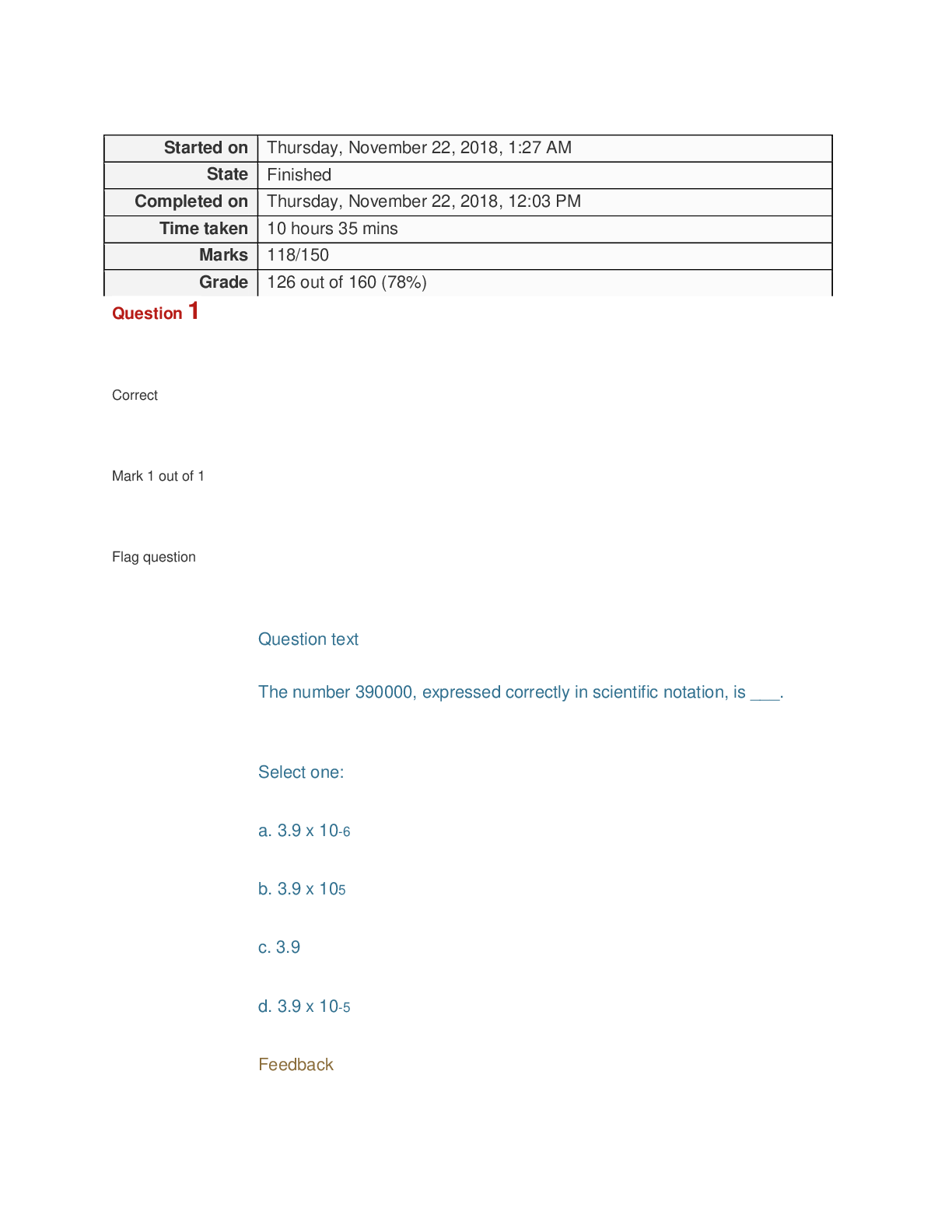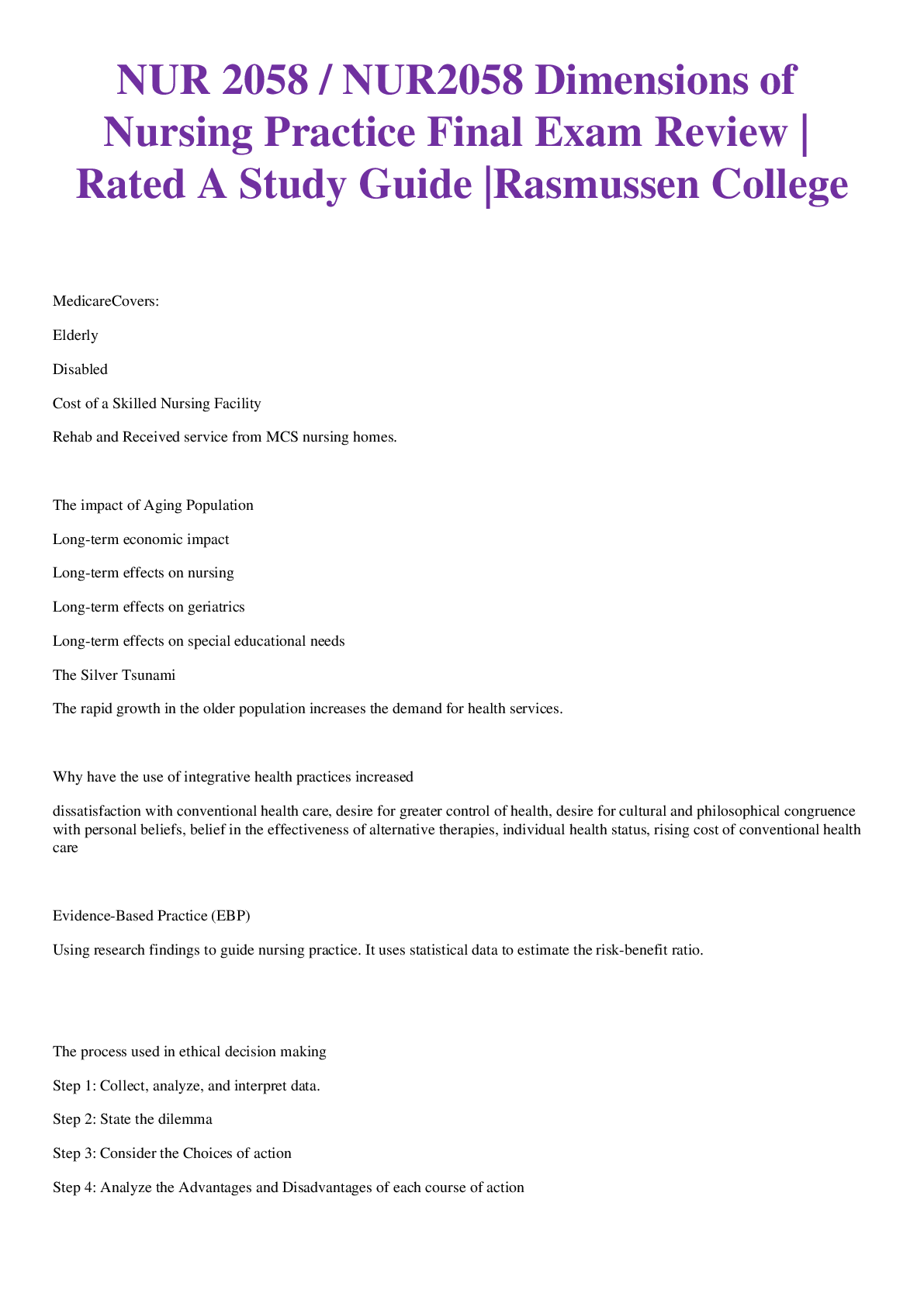*NURSING > EXAM REVIEW > NSG 6435 Final review Exam Peds : Family Health - Pediatrics: South University (Latest UPDATE) (All)
NSG 6435 Final review Exam Peds : Family Health - Pediatrics: South University (Latest UPDATE)
Document Content and Description Below
NSG 6435 Final review Exam Peds 1. What medical term is used to identify inflammation disorder of the skin that is often considered synonymous with dermatitis and characterized by pruritus’ with ... lesion that have indistinct border: • Eczema. • Pityriasis versicolor • Pityriasis rosea • psoriasis 2. DERMATOPHYTE skin infection can be diagnosed from skin scraping and prepared with which solution for microscopic exam: • 10% or 20% potassium hydroxide KOH solution. • Hydrochloric acid • Distilled water • Gram stain 3. ACIRCUMSCRIBED elevated lesion more than 1 cm in diameter in containing clear serous fluid is best described as: • Bullae • Pustule • Vesicle • papule 4. When assessing in children’s hydration status the best place to evaluate skin turgor on an adult is: • on the back of the hand • on the inside of the forearm • just below the clavicle • the fleshy part of the arms and legs • 4. what is the treatment for strawberry hemangioma? • Support involution. • Cosmetic medical removal • Oral antibiotics • Topical steroids 6- Which Of The Following causes condylomas acuminata or genital wart: • human papilloma virus (HPV). • Herpes simplex virus (HSV1) • Adenovirus • Chlamydia 7- A young Female presents to the Family Nurse Practitioner’s office stating that she has a red rash over her trunk for 2 weeks that does not itch, She Has OTC lotion and creams but the rash is still there the rash started as a small round red patch on her chest and has seen spread across her chest back arms and legs physical exam reveals a generalized distribution of erythematous in scaly macular lesion that run parallel to each other creating a Christmas tree pattern the family nurse practitioner should teach the patient : • Teach the patient This viral disease is self-limiting last thing 6 to 8 weeks and to avoid prolonged or excessive exposure to sunlight. • Prescribed triamcinolone cream 0.025% bid x 2 weeks • Refer patient to dermatology for biopsy • Do a thorough medication hx, investigate any potential allergy, send to allergy specialist 8- Which clinical manifestation is present in with rubella and not rubeola: • conjunctivitis • presence of cough • runny nose or stuffy nose (coryza) • enlarge lymph nodes 9- The disruption in cellular adhesion observed in bull PID impetigo is cause by an exfoliating r/t Which organism? • Staphylococcus aureus. • Streptococcus pyogenes • Candida albicans • Escherichia coli 10- Rubeola Is a highly contagious acute disease in children caused by which type of infection: • Pink to red coalescent Maculopapular rash on the scalp or trunk. • Circular round and oval lesion with erythema and scaling patches • Vesicles that rupture creating a thin, flat honey crusted colored crust (impetigo) • Red papules, vesicles, and pustules in clusters. 11- Skin lesions that ruptured creating a thin flat honey colored crust are the hallmark clinical manifestation of which skin disorder? • Bullous Impetigo. • Tinea capitis • Rubella (German measles) • Atopic dermatitis A- patient complaining of hyper Hyperhidrosis should be counseled that • A history and physical need to be completed to rule out any medical etiologies. • There are no therapies for this patient • This is normal occurrences • Bathing in 20% alcohol solution of aluminum chloride hexahydrate(drysol) 13-Which acne lesions are classified as inflammatory? Please select all that apply: • Pustules • Nodules • Papules • Opened comedones (acne primary sign) 14- The Family Nurse practitioner inspecting a dark-skinned individual for signs of jaundice, the best place to observe skin color in dark skin individual is: • Sclera of the open Eye. • Nail beds • Palm & soles of the hand and feet • Oral mucosa 15- During an assessment, the family nurse notes the client’s nails to look at the picture - what would be a probable diagnosis? Koilonychia, also known as spoon nails • Koilonychia • Nail pitting • Beau’s lines • Finger clubbing 16- Which clinical manifestation is considered the hallmark of atopic dermatitis: • Itching • Vesicle that burst from crust • Popular rash • High fever 17- What term is used to identify an inflamed hair root: • Furuncle. • Tinea • Verruca • erysipelas 18- The family nurse practitioner has made a diagnosis of ONCHOMICOSIS. Which picture would the family nurse practitioner notes while performing physical exam of the patient: • A • B • C • D 19- Folliculitis is most commonly due to: • Staphylococcal infection. • Contact dermatitis • Dermatophytes ( fungus) • Varicella zoster ( chicken pox) 20- What is the recommended treatment for rosacea: a. low dose tetracycline b. topical 5-fluorouracil c. oral hydrocortisone d. oral ketoconazole 21- Your pediatric patient presents for an office visit with complaints of Measles like rash on his truck and spread to his extremities, he was seen several days ago for bronchitis and started on Bactrim Septra DS one tab PO BID. what is the recommended action for the family nurse practitioner: a. Discontinue TMP-SMX (Bactrim) b. Take medication for 3days and restart drug c. Instruct Pt to continue medication and see any changes occurs in the rash 22- A patient complains of Intolerance itching in the pubic hair an exam the family nurse practitioner notes Erythematous, papules and tiny white specks in the pubic hair . the differential diagnosis include all except : a. IMPETIGO, b. atopic dermatitis c. pediculosis pubis d. scabies 23- The family nurse practitioner is examining a patient with a diagnosis of PITYRIASIS ROSEA which three statements are correct about the condition a. salmon colored Patch with fine scales is commonly noted on face hands and feet b. Typical Christmas tree pattern lesion distribution is observed c. presence of Herold Patch before onset of generalized rash d. pruritis is not present e. vesicles progressing to progressing 2 pustule within two to three days of eruption 24- Which skin disorder begins with a single lesion that is circular demarcated and Salmon pink ,measures approximately 3 to 4 centimeter in diameter and is usually located on the trunk a. Acne rosacea b. psoriasis c. lichen planus d. PITYRIASIS rosea 25- What term is used to identify skin lesions that are elevated round and firm with irregular clawlike margin that extend beyond the original site of injury : a. keloid b. dermatitis c. Psoriasis d. acne 26A young male patient present to the family nurse practitioner office complaining of flulike symptoms a large red spot in the right groin headed in generalized muscle pain these symptoms have persisted for about four to five weeks in taking the history he will be most important to determine whether the patient : a. has a recent insect bite or was potentially exposed to insects such as tick b. has been exposed to a person with tuberculosis c. was using new skin care products d. was taking new medication such as vitamins and herbal therapies 27-What is the cause of molluscum contagiosum a. virus b. bacteria c. rickettsia d. fungi 28.Which of the following would you treat with topical antibiotic No answer except for this pic 29- missing 30 missing 31-missing 32-missing 33- Clubbing of the nails commonly occurs in patients with chronic respiratory condition the family nurse practitioner access is for this condition by : • placing nailbed of each index finger together to determine angle of nail plate • evaluating the nail for transverse depression in ridges • determining if there's a diffuse discoloration of the nail bed from decrease oxygenation • placing the patient hands together with palm towards the index finger aligned 34-Which contagious diseases caused by the each mite • scabies • pediculosis • Miliaria • tinea corporis 35 -the treatment choice for Rocky Mountain spotted fever for six year old patient with NKA is the following • doxycycline • amoxicillin • Azithromycin • Chloramphenicol 36 -in latex allergies which immunoglobulin IG is associated with an immediate reaction • IgG • IgA • IgE • IGb4 37- Frequently diaper dermatitis is secondarily infected with which Organism • candida albicans • E coli • proteus spp • Staphylococcus aureus 38- The history and physical of a patient indicates past occurrences of lichenification ,The family nurse practitioner identifies the characteristic of this lesion as : • rough thickened epidermis accentuated skin margins • dried crusty exit date slightly elevated • keratinized cells shaped in an irregular pattern with exfoliation • loss of epidermis with hollowed out area in dermis exposed 39- Which type of lesion is referred to as resembling a dewdrop on a rose petal • varicella zoster • rubella • measles • tinea 40- Which one of the following lesion is found in secondary syphilis? • rough red or reddish Brown spot both on the palm of the hands and the bottom of the feet • painless chancres • there are no visible sign of symptoms of syphilis • it can affect multiple organ system • 41. A patient has a diagnosis of scabies. Which presentation would the family nurse practitioner expect to note on physical exam? A) B) C) D) 42. Which skin disorder is characterized by a vesicular eruption after prolonged exposure to perspiration, with subsequent obstruction of the eccrine ducts? (major sweat glands of the human body) A) pediculosis B) Tinea corporis C) Miliaria D) Scabies 43. On exam of a patient’s skin, the family nurse practitioner finds a lesion that is about 0.75 cm in diameter, brown, circumscribed, flat, and nonpalpable. What is the correct term for this lesion? A) Macule B) Papule C) Nodule D) Wheal 44. Lesions on the elbows and knees that are well demarcated, thick, silvery, scaly, and erythematous characterized which type of psoriasis? A) Plaque B) Bullae C) Vesicle D) Lichen 45. The family nurse practitioner has made a diagnosis of psoria Vulgaris after noticing tiny bleeding points when one of the lesion is scrapped (Auspitz’s sign). Which image is consistent with the clinical presentation of psoriasis? A) C B) A C) B D) D 46. What is true about Human Papilloma Virus (HPV). Please select all that apply: A) Viruses that cause warts. B) Wart viruses are contagious C) People with a weakened immune system (the body’s defense system) are prone to get them D) There are a few different types of warts. The type is determined by where it grows on the body and what it looks like. E) Children and teens are prone to get them. 47. The rash in syphilis has the following characteristics: A) Itch rash is a hallmark of syphilis B) Usually does not cause itching C) Always cause itching D) Itch rash is a hallmark of syphilis 48. What kind of lesions are caused by the herpes simplex virus? A) Scales B) Vesicles C) Uticaria D) Plaques 49. Which statements are true regarding a Nevus? A) Nevi are characterized by irregular borders. B) Nevi share a relationship with melanoma. C) Nevi begin to form at the age of 3 to 5 years. D) A nevus is an aggregation of malanocytes E) Nevi always warrant being removed. 50. The Wood’s lamp may be used to evaluate skin lesions. When the light is shone on the patient’s skin, a green-yellow fluorescence indicates: A) Lichenification B) Bacterial colonies C) Keratinized cells D) Prescence of fungi 51. Please select all that apply regarding the following lesion describe as follows “ A pink or flesh-colored bumps on the skin. These bumps can appear anywhere on the skin”. A) People who have a weakened immune system are more prone to have it. B) it is highly contagious C) Wrestlers and gymnasts may get it from touching infected mats. D) Children have a high risk to contact this lesion. 52. What type of skin infection is tinea corporis ( ringworm)? A) Viral B) Bacterial C) Nematode D) Fungal 53. Optimal medical therapy for young infants with vomiting or regugitation of gastroesophageal reflux disease (GERD) consists of: A) Frequent small feedings and burping after each feeding. B) Placing the infant prone after frequent feedings. C) Placing the infant supine after feedings. D) Thickening the feedings and using proton pump inhibitors. 54. A 6-year-old patient with a history of asthma presents to the office for evaluation by the family nurse pratitioner. The child has never used a peak flowmeter. What quick tool can the family nurse practitioner use to assess the severity of the child’s distress? A) ABG’s B) Chest X-ray C) Presence of runny nose D) Child’s inability to complete a sentence 55. Indications for antibiotic use in a child with bronchiolitis would include: A) History of two episodes in 4 months B) Rhinitis and a productive cough C) Low-grade fever and sibilant wheezes D) High fever and rales 56. A new born has a vascular lesion that will not fade as the child gets older. What is your diagnosis? A) Port-wine stain B) Salmon patch C) Capillary hemangioma D) Café au lait spot 57. A 5 year-old presents to the clinic with diffuse abdominal pain, irritability, and a low- grade fever. The mother states the child has not had a bowel movement since the previous morning. Physical examination reveals umbilical tenderness, guarding, and hypoactive bowel sounds. The family nurse practitioner’s next step is to: A) Refer to physician/ surgeon for further evaluation B) Prescribe pediatric Fleet enemas C) Assess for rebound tenderness and do a rectal exam D) Assess dietary intake for the past 24 hours 58. Antibiotic administration has been demonstrated to be of little benefit in the treatment of which of the following disease processes? A) Bacterial sinusitis more 14 days B) Chronic bronchitis C) Acute bronchitis D) Aged-school child with pneumonia 59. A 3 year old child who is enrolled in Head Start is suspected of having developmental delays based on Denver Development II results at two separate clinic visits. What would be the next step in the plan of care? A) Request Head Start complete an independent evaluation B) Discuss interventions to foster development with the parents C) Repeat testing in one year D) Refer the child for a more definitive evaluation 60. A 10-year-old boy is experiencing problems with wheezing, coughing, and shortness of breath about 4 hours after basketball practice. He has normal respirations and only experiences the problems after exercise. He is experiencing no other respiratory problems, and the physical findings are within normal limits. What is the treatment of choice for this child? A) Cromolyn sodium (Intal) 2 puffs each morning. B)Theophylline (Theo-24; methylxanthine) 100mg po bid C) Beciomethasone (Beclovent) 2 puffs 3-4 times daily D) Albuterol (Ventolin) 2 puffs MDI 20-30 minutes before exercise 61. Which of the following is correct in response to a patient's Question concerning possible cause of testicular cancer? A. Balanitis B. Syphilis C. Cryptorchidism D. Gonorrhea 62. A common cause of acute abdominal pain in children under 5 years old is: A. Incarcerated hernias B. Gastroenteritis C. Intussusception D. Appendicitis 63. The family nurse practitioner is preparing to examine the Abdomen of a patient. What is the correct. sequence in which to conduct the exam? A. Percussion, palpitation, auscultation, inspection. B. Inspection, auscultation, percussion, palpitation C. Palpitations, percussion, auscultation, inspection. D. Inspection, Palpitation, percussion, auscultation 64. A family nurse practitioner knows. Normal breath sounds that have a low pitch and soft intensity and that all heard best on inspiration over the posterial long fields are called; A.Vesicular B. Bronchial C. Rhonchial D. Bronchovesicular 65. Which of the following best measure of toddler's development A. M-Chat B. Vineland scale C. Bayley scale6 D. Denver II 66. Cystic Fibrosis (CF) is the preliminary diagnosis For a young girl who was brought to the clinic for evaluation. The test that will be used to rule out CF is Glucose tolerance test Hemocult test Sweat chloride test Sputum culture and sensitivity 67. In a 17 year old man which of the following likely responsible for epididymitis? A. Chlamydia Trachomatis B. Candida Albicans C. Escherichia coli D. Treponema palladium 68. A patient from 12 to 60 years old who has a (FEV) Forced expiratory volume greater than 80%, has been experiencing night time awakenings (4-5 X/month) and using a short acting B2 agonists 3-4X/Week and report minimal limitation to normal activity would be classified as: A. Severe persistent. B. Mild persistent C. Intermittent D. Severe persistent 69. An exam of the male genitalia that consist of inserting a finger into the Louis cordam and into the inguinal canal, and asking the patient to cough causes the nurse practitioner to feel a sudden presence of a viscus that lies within the inguinal canal and comes through the external canal passing into the scrotum is most likely called: A. A direct inguinal hernia B. An indirect inguinal hernia C. A strangulated inguinal hernia D. A femoral hernia 70. An illed pediatric patient with respiratory symptoms has the following CXR based on this imagery what is the most likely microorganism? a. Haemophilus influenza b. streptococcus pneumonia c. rotavirus d. mycoplasma pneumonia 71. An 18-month-old child is brought to the clinic by her mother and is complaining of abrupt onset of vomiting. Followed by more than 10 liquid stools with mucus for the past 48 hours. The temperature is 100 degrees F (37.8) orally. The stool smear by the family nurse practitioner is negative for WBC’s. What is the most likely etiologic pathogen for this young child’s gastroenteritis? a. Shigella dysenteriae b. Salmonella c. Campylobacter jejuni d. Rotavirus 72. Missing?????? 73. A 3-year-old child with up to date immunizations is brought to the office by his mother with a fairly rapid onset stridor and high-pitched wheeze. In view of this information, what would be the least important condition to consider for the differential diagnosis? a. Croup b. Bacterial tracheitis c. Foreign body aspiration d. Epiglottitis 74. When determining the classification of asthma control in a patient from 12 to 60 years old, who has symptoms less than 2 days per week, no interference with normal activity, reports nighttime awakening 1 time or less per month and using a short acting B2 agonist 3-4 times per week, the family nurse practitioner would classify the patient as: a. Well-controlled b. Very poorly controlled c. Not well-controlled d. Out of control 75. A 3-year-old child is seen in the clinic for chronic, relapsing diarrhea. A stool for ova and parasites is obtained and is positive for Giardia. What is the most appropriate pharmacologic intervention? a. Metronidazole (Flagyl) b. Erythromycin (E-Mycin) c. Ampicillin (Omnipen) 76. Match the description of the skin lesions with the disorder where it is found. 1. Nevus (flat mole): Flat circumscribed area that is less than 1 cm in diameter 2. Psoriasis or seborrheic and actinic keratosis: Elevated, firm, and rough lesion with a flat top surface greater than 1 cm in diameter 3. Varicella (Chickenpox), herpes zoster (shingles): Elevated circumscribed superficial lesion filled with serous fluid, less than 1 cm in diameter 4. Urticaria allergic reaction: Elevated irregular-shaped area of cutaneous edema; solid and transient with a variable diameter 77. During examination of a 3-week-old it is noted that the child has irritability when lifted or carried, asymmetrical Moro reflex and spasms along the right sternocleidomastoid. What does this suggest? a. Klippel-Feil syndrome b. Torticollitis c. Sprengel deformity d. Fractured clavicle 78. The family nurse practitioner is teaching a patient about the role of medications in the treatment of asthma. Which statement by the patient would require further teaching? a. “The Salmeterol that I take provides me with long-term control” b. “I need to use my peak-flow meter to self-monitor how I am doing” c. “I do not need to use a spacer with my MDI” d. “My albuterol is my quick-relief mediation” 79. Which of the is a typical presentation of a dislocation in the hip of a child 6 months of older? a. Asymmetry of skin folds b. Negative Trendelensburg sign c. Positive Barlow & Ortolani sign d. Atrophied hip muscles 80. Lesions on the elbows and knees that are well demarcated, thick, silvery, scaly, and erythematous characterize which type of Psoriasis? c. Guttate d. Plaque 81. On a routine physical exam, a patient expresses concern over the observation that one side of his scrotum is larger than the other side. He states it has been getting larger for the past few months and and that the scrotum is smaller in the morning and enlarges through the day. He has felt a heaviness in the scrotum, denies any acute pain. He reports no history of trauma to the scrotal area. On exam, the family nurse practitioner confirms the enlargement and further exam reveals that the scrotum transilluminate and that manual manipulation of the scrotum does not cause pain. What is the initial diagnosis for the patient? a. Traumatic injury b. Orchitis c. Hydrocele d. Epididymitis 82. Which medication inhibits bronchoconstriction and is used as an adjunct to bronchodilators and corticosteroids and is effective in promoting a decrease airway inflammation as well as providing long-term medication coverage in a patient with asthma? a. Albuterol (Proventil; Ventolin) b. Montelukast (Singulair) c. Salmeterol (Serevent) d. Beclomethasone (Vanceril; Beclovent) 83. Vomiting in infancy has a long list of differential diagnoses. Which accompanying symptom would most likely indicate pyloric stenosis? a. Appropriate growth b. Diarrhea c. Acts hungry after vomiting d. Sausage-shaped mass in abdomen 84. Which of the following findings could be expected to occur in a baby with intussusception? a. Inconsolable screaming and bringing knees to chest b. weight loss c. left to right peristaltic waves d. Olive shaped mass 85. A pediatric patient presents with symptoms consistent with the early phase of appendicitis. Which of the following would NOT be a likely presentation? a. Severe localized right lower quadrant pain b. Fever and Diarrhea c. Abdominal pain after eating d. Anorexia and diffuse pain 86. The nurse Practitioner is completing education with parents of a child with Celiac disease. Which of the following foods would be most appropriate? a. Oatmeal or whole grain cereal for breakfast b. Cream of baked bread c. Commercial backed bread d. Boiled rice with Vegetable and butter 87. A male patient presents with symptoms consistent for a torsion. What would be the first priority for this patient? a. Bedrest b. Surgical referral c. Ice d. Scrotal elevation 88. The nurse practitioner has a differential diagnosis of Lyme Disease. Which of the following skin lesion would confirm the diagnosis? a. Erythema migrans b. Koplik spots c. Pustules d. Scales 89. Which of the following would best reflect the physical presentation in a newborn with Down Syndrome? a. Pigeon-breasted chest, Brushfield spots, arachnodactyly b. Hypotonia, large-appearing tongue, small mouth, upward eye slant c. Microcephaly, flattened philtrum, downward eye slant d. Lymphadenopathy, coarctation of the aorta, webbed neck. 90. Fill in the blank: Sickle cell disease is a chromosomal disorder. a. autosomal dominant b. autosomal recessive c. X-linked recessive d. X-linked dominant 91. You are the nurse practitioner in the office today. A child comes in with their parent after an injury that occurred this morning. The child had his hand in the door jam of the car and his brother accidentally closed the door on his brother’s hand. The child has multiple open lacerations and cannot move his fingers. You suspect there is a fracture. You examine the patient and decide you are going to a. order an x-ray. b. have your medical assistant prep the patient for a laceration repair. c. send the patient to the ED. d. clean the areas and apply a clean dressing. 92. A nurse practitioner is seeing a pediatric patient in a follow-up visit after the child experience a febrile seizure. Which of the following statements would be the most accurate when educating the parents on febrile seizures? a. The child will be at an increased risk for epilepsy b. The child would benefit from Phenytoin c. The child would benefit from phenobarbital d. The risk for subsequent seizures is 30-50% 93. During a routine well-child examination of a 4-year-old, the family nurse practitioner learns that the paternal grandmother has just been diagnosed with active TB. The mother states that the grandmother had stayed in their home for a week during the summer. The child has no signs of TB and has a negative PPD. What action should the family nurse practitioner take? a. Prescribe no medications, but schedule a repeat PPD in 2 months. b. Start combination therapy with isoniazid (INH) and rifampin (Rifadin) for 15 months. c. Administer 1 mL gamma globulin IM d. Start isoniazid (INH) therapy for 4 months and then reevaluate 94. Please identify the location of the abnormality A. Left uppert lobe B. Upper right lobe C. Middle and lower right lobe D. Middle and lower left lobe 95. What is an expected finding in young infants with Cerebral Palsy (CP)? a. Weight gain and increased appetite b. Reactions to initial Vaccines C. Hypotonia in the first weeks of life d. Hepatosplenomegaly 96. Fred is a six-year-old male brought to your practice by his foster mother. Fred’s mother reports that he is a very active boy and cannot seem to stay on task when given something to do. His teacher in his new school reports that he is disruptive in class. The foster mother has no PMH or family history on this child. You are presented with an animated and distractible male child. He has no negative physical findings. Which tool do you believe would be most appropriate for initial assessment of this child? a. Pediatric symptom checklist b. Vanderbilt scale c. M- CHAT d. Child depression inventory 97. a. Ambiguous CXR b. Abnormal CXR c. Normal CXR d. Bad quality of CXR/needs to repeat it 98. The family nurse practitioner understands that an appropriate medication regimen for a child with drug-susceptible pulmonary tuberculosis (TB) is: a. Montelukast therapy with pyrimethamine (Fansidar) b. Sterptomycin, pyrazinamide and rimantadine (Flumadine) c. Montelukast (Singulair) therapy with rifampin (Rifadin) d. Isoniazid (INH), pyrazinamide, and rifampin 99. The family nurse practitioner is interpreting the notation of “string sign” on an upper GI series performed on an infant. This is associated with a diagnosis of: a. Intussusception b. Pyloric stenosis c. Gastroesophageal reflux d. Hirschsprung’s disease 100. A parent calls the pediatric clinic questioning about what he should do about his child who tripped and fell on the sidewalk, and subsequently hit his head. Which of the following symptoms would require that the child needs to go to the emergency room? a) History of febrile seizure b) Scalp Bruise c) Crying d) Loss of consciousness 101. The family nurse practitioner understands that the following characteristic is more likely to occur when the patient has pneumonia (due to Streptococcus Pneumoniae) rather than bronchitis: a) Wheezing b) Dyspnea c) Purulent sputum production d) Non-Productive Cough 102. Which statement is true regarding Koplik spots? Please select all that apply. a) The lesions are surrounded by a red ring. b) The lesions of Koplik spots are large in size. c) Koplik spots are associated with rubeola. d) They appear as white spots. e) Koplik spots are primarily found on the buccal mucosa. 103. The nurse practitioner is completing a cardiac assessment on a child and detects a murmur. Which of the following is true regarding innocent murmur? a) The murmur is often holosystolic. b) The precordial thrill is present. c) Prompt referral to cardiologist is indicated. d) The murmur is low intensity 104. A child presents to the primary care clinic with chest pain. The provider is aware that chest pain in children is usually what? a) A symptom of congestive heart failure b) A symptom of congenital heart disease c) A sign of hypercholesterolemia d) Noncardiac in nature. 105. Which of the following is a common cause of acquired coronary artery disease during childhood? a) Hypertension b) Kawasaki Disease c) Systemic Lupus Erythematosus d) Rheumatic Fever 106. What type of hemorrhage would be expected with severe factor VII deficiency? a) Severe hemorrhage following moderate trauma b) Gross bleeding following mild trauma c) Gynecologic hemorrhage d) Spontaneous hemarthroI click on it and then OK let's see sis 107. The nurse practitioner has a possible diagnosis of Leukemia in a pediatric patient. Which of the following test are required for that diagnosis? a) Bone marrow aspiration b) Chest radiograph c) CBC with differential d) Biopsy of an enlarged lymph node. 108. The primary care pediatric nurse practitioner reviews a child’s complete blood count with differential white blood cell values and recognizes a “left shift” because of a) A decrease eosinophil count. b) A decreased lymphocyte count. c) An elevated monocyte count. d) An elevated neutrophil count. 109. The primary care pediatric nurse practitioner performs a well-baby examination on a 4-month-old infant who is exclusively breastfed and whose mother plans to introduce only small amount of fruits and vegetables in addition to breastfeeding. To ensure that the infant gets adequate amounts of iron. What will the nurse practitioner recommend? a) Elemental iron supplementation of 1 mg/kg/day until cereal are added. b) Elemental iron supplementation of 3 mg/kg/day for the duration of breastfeeding. c) Monitoring the infant’s hemoglobin and hematocrit at every well-baby check-up. d) Offering iron-fortified formula to ensure adequate iron intake. 110. A toddler who presents with anemia has a history of gradual decrease in energy and increase in pallor beginning after a recent viral infection. How will the primary care pediatric nurse practitioner treat this child? a) Closely observe the child symptoms and lab values. b) Consult with a pediatric hematologist. c) Prescribe supplemental iron for 4 to 6 months. d) Refer to transfusions to correct anemia. 111. A 15-year-old female reports fainting at school in class on two occasion. The adolescents orthostatic blood pressures are normal. The primary care pediatric nurse practitioner suspects a cardiac cause of these episodes and will order which test before referring her to a pediatric cardiologist? a) 12 lead Electrocardiogram b) Echocardiogram c) Tilt table testing d) Treadmill Exercise testing e) 112. The primary care pediatric nurse practitioner is performing a sport physical on an adolescent whose history reveals mild aortic stenosis. What will the nurse practitioner recommend? a) Avoidance of all sports to prevent sudden death. b) Clearance for any sports since this is mild c) Evaluation by a cardiologist prior to participation. d) Low- intensity sports, such as golf or bowling. 113. What is the initial treatment of choice for children diagnosed with bronchiolitis? a) Amoxicillin over 10-14 days; aerosol humidification. b) Increase fluids; antipyretics as needed. c) Prednisone (Pediapred) Immediately and continue over 3-5 days. d) Diphenhydramine HCL (Benadryl) as long as symptoms persist. 114. A 13-year-old present with several vesicles and honey colored crusted lesions on the child’s face. The initial injury was a scratch. What would be the most likely diagnosis? a) Acne b) Impetigo c) Eczema d) Herpes Simplex 115. What question by the family nurse practitioner would be appropriate to ask the parents of an infant suspected of intussusception? a) Does the infant have red currant jelly stool? b) Does the infant have projectile vomiting? c) Does the infant have clay-colored stool? d) Does the infant have constant abdominal pain? 116. During a first-time office visit, the family nurse practitioner sees an adult female with history of Asthma. She had been using albuterol (Proventil) metered dose inhaler (MDI) on inhalation twice monthly over the past several years. Based on the Global Initiative for Asthma (GINA) guidelines, the family nurse practitioner diagnosed ( intermittent) mild persistent asthma and starts her on “Step 2” therapy which includes: a) Fluticasone and Salmeterol (Advair) 100 mg/50 mg, one inhalation twice daily. b) Fluticasone (Flovent) 44 mcg, two inhalations daily. c) Salmeterol (Serevent) 42 mcg one inhalation twice daily. d) Fluticasone and Salmeterol (Advair) 250 mg/50 mg, one inhalation twice daily. 117. Which of the following would be prescribe as initial treatment for uncomplicated GERD with negative Helicobacter Pylori? a) Famotidine (Pepcid) 25 mg daily. b) Clarithromycin 500 mg bid. c) Bismuth (Pepto-Bismol) 2 tablets twice a day. d) Omeprazole (Prilosec) 20 mg qd. 118. The family nurse practitioner reviews laboratory results for a patient that reveals a positive Helicobacter pylori stool antigen test. The family nurse practitioner would want to treat this if the patient complained of: a) Upper Abdominal Pain b) Altered bowel habits. c) Nausea d) Dysphagia 119. A 10-year-old taking isoniazid (INH) prophylactically for exposure to TB complains of headache, palpitations, rash and diarrhea. Management would be based on: a) Change in therapy from INH to rifampin. b) Avoidance of food containing tyramine and histamine. c) Evaluation for hepatic impairment. d) Addition of pyridoxine to the diet. [Show More]
Last updated: 1 year ago
Preview 1 out of 30 pages
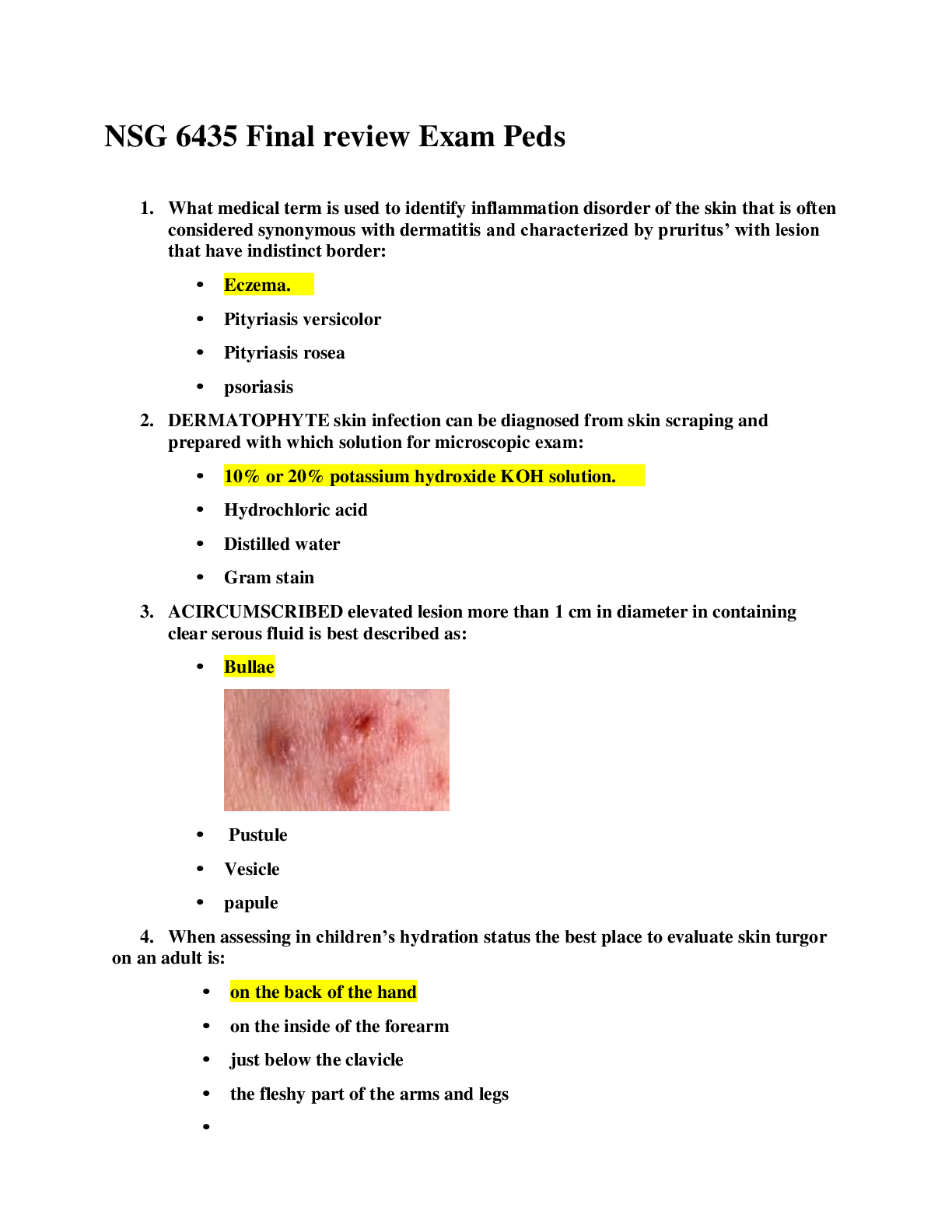
Reviews( 0 )
Document information
Connected school, study & course
About the document
Uploaded On
Oct 25, 2022
Number of pages
30
Written in
Additional information
This document has been written for:
Uploaded
Oct 25, 2022
Downloads
0
Views
38




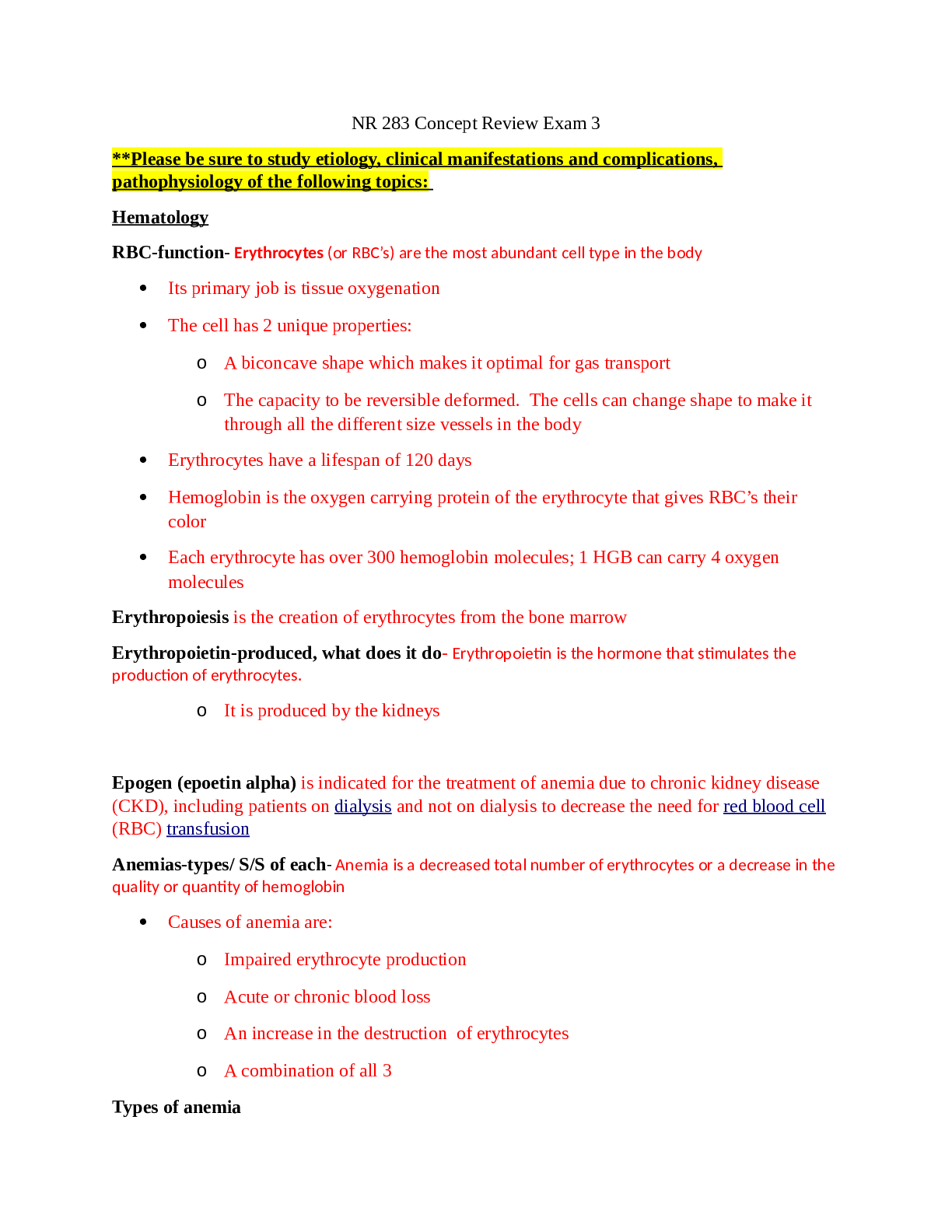
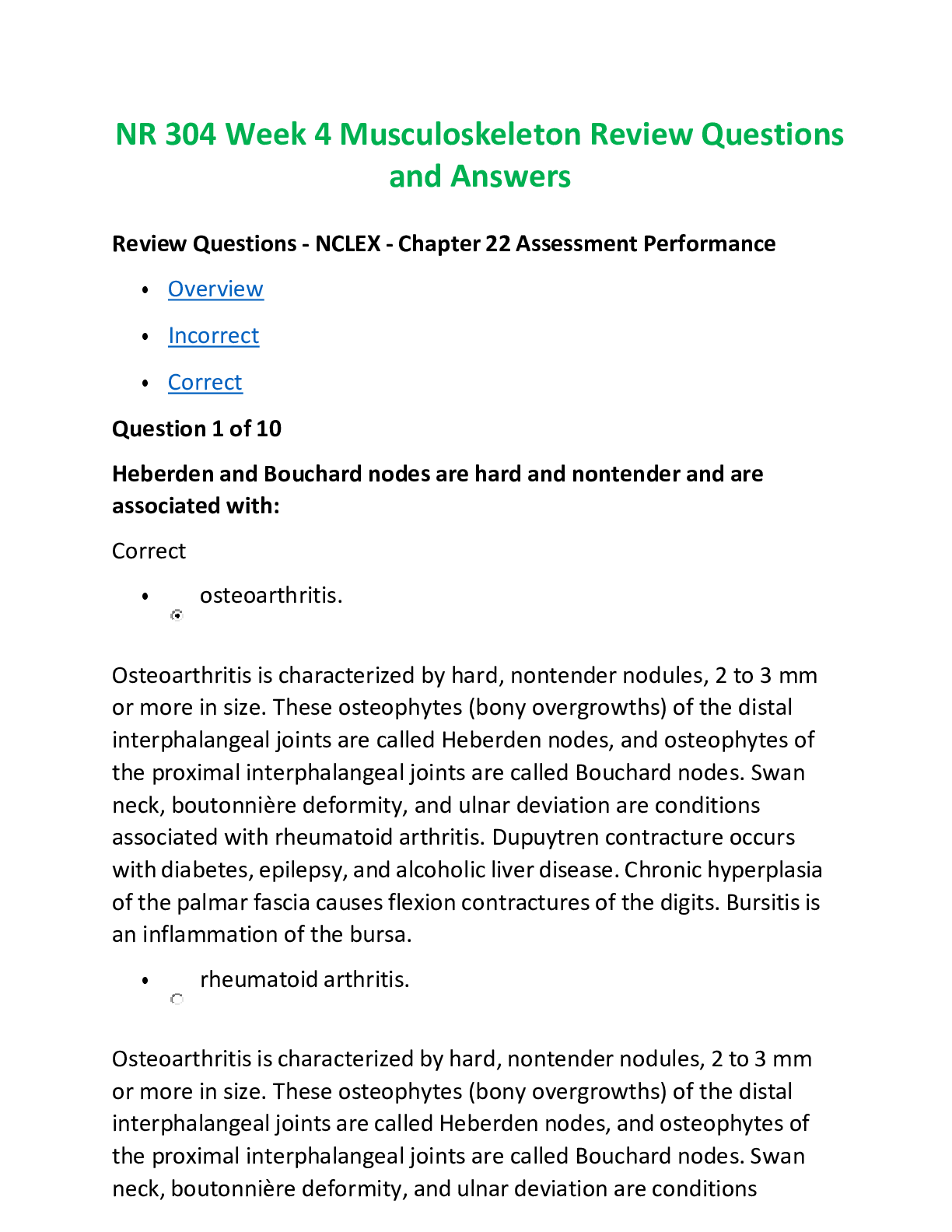

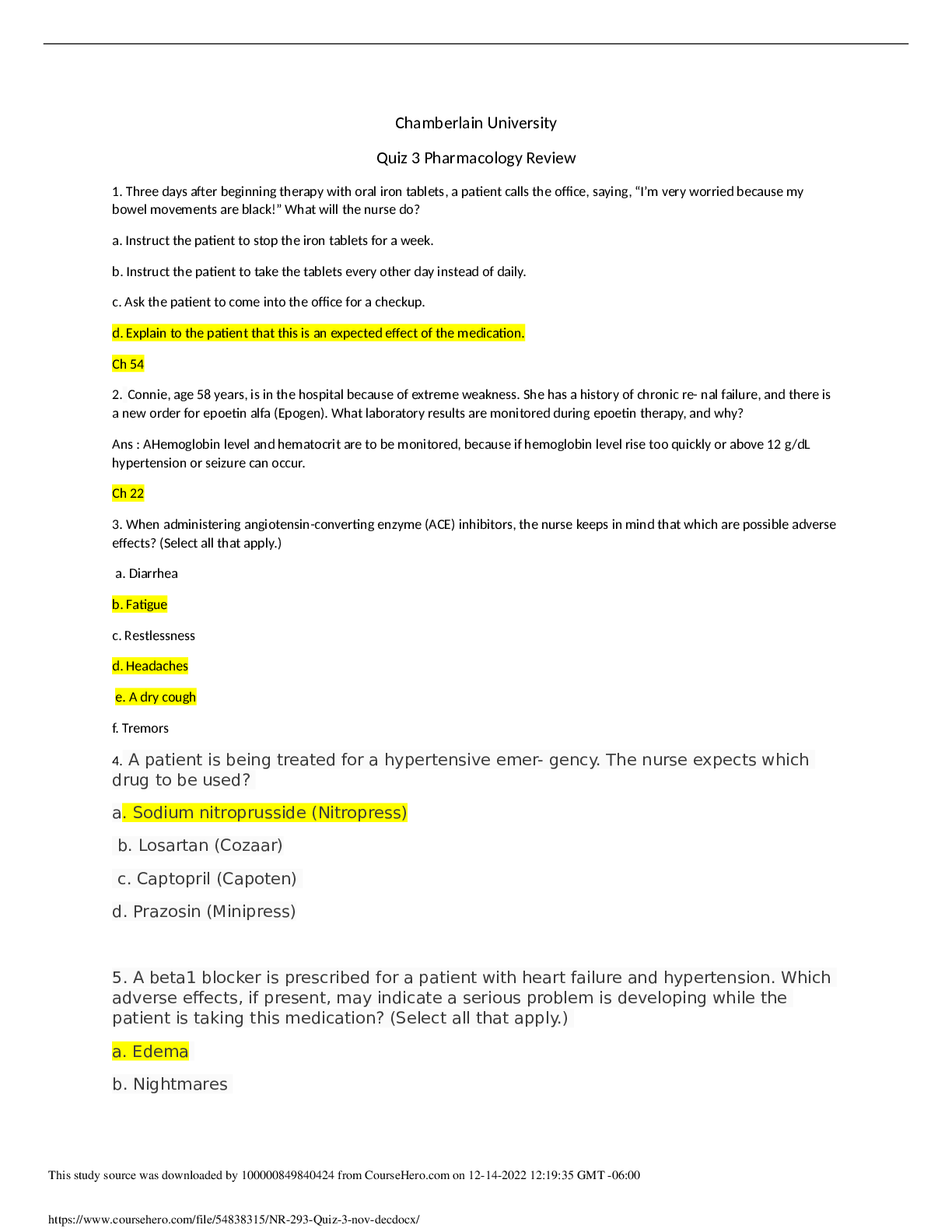

.png)
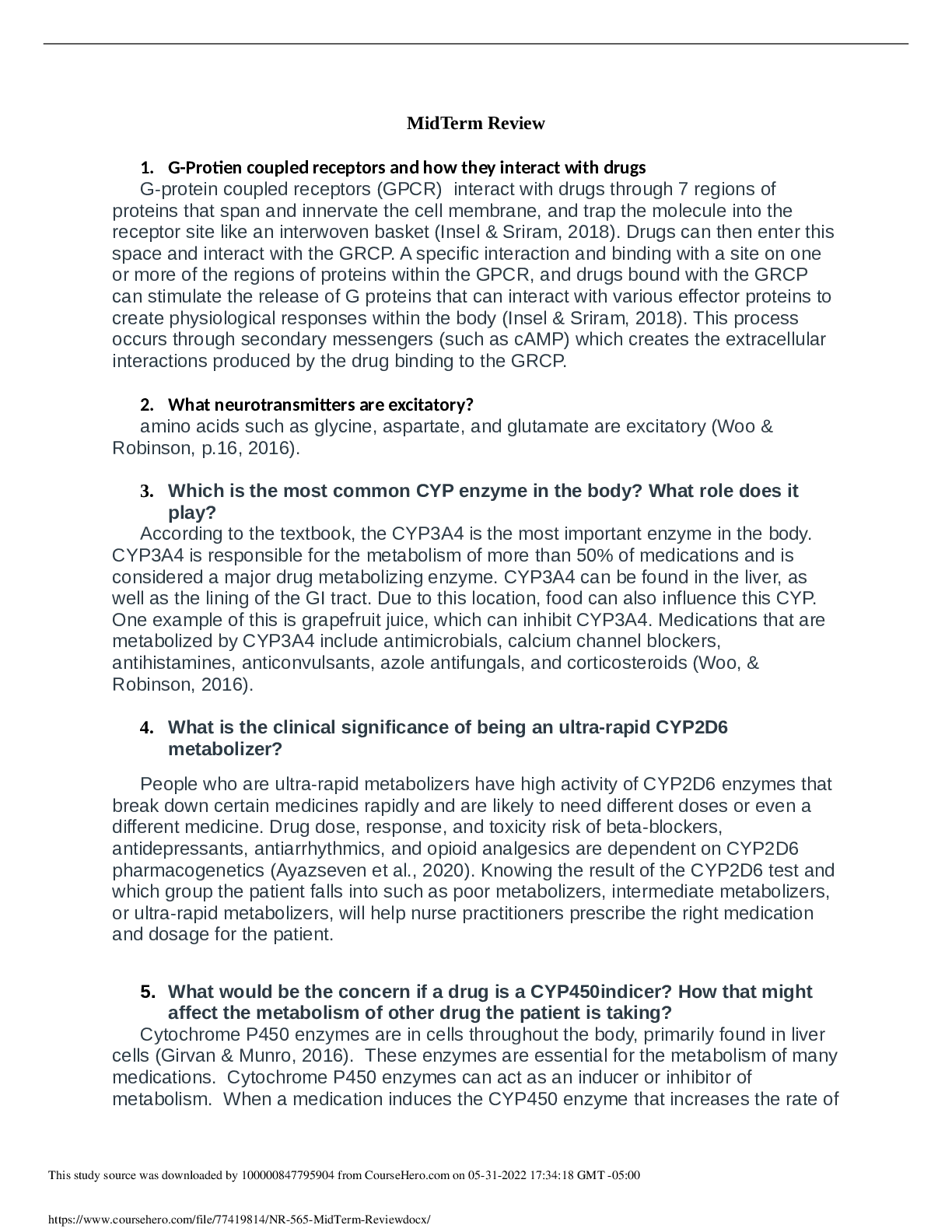
.png)

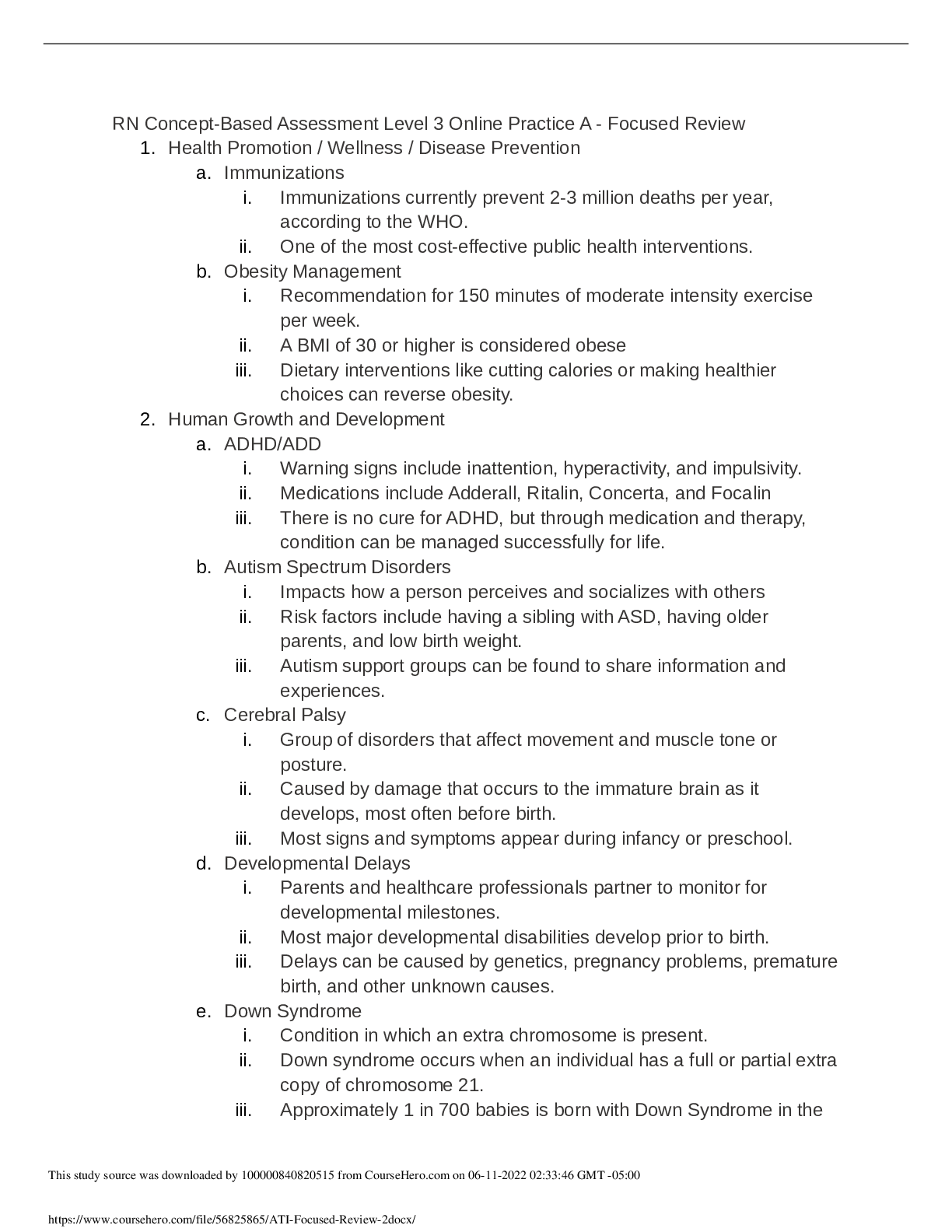

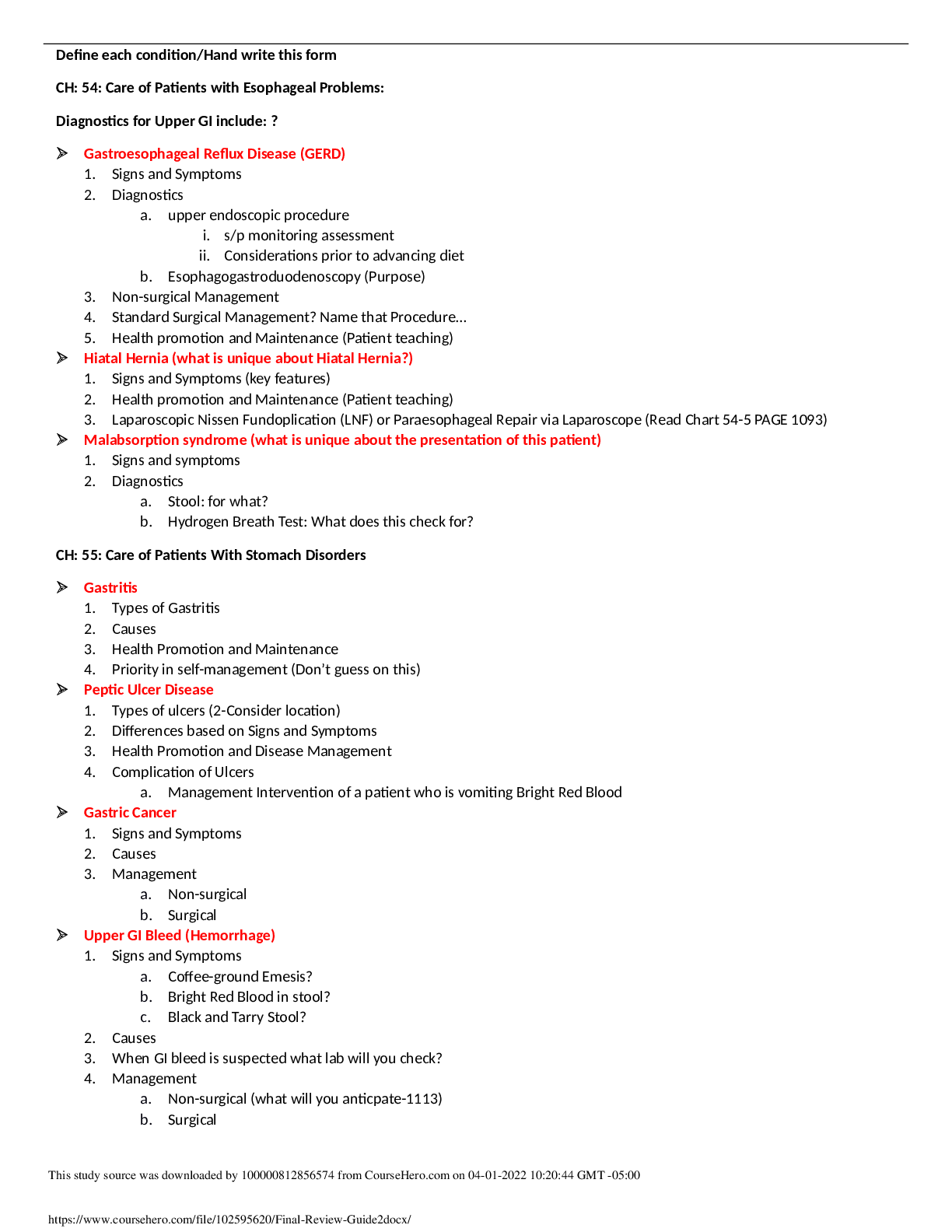
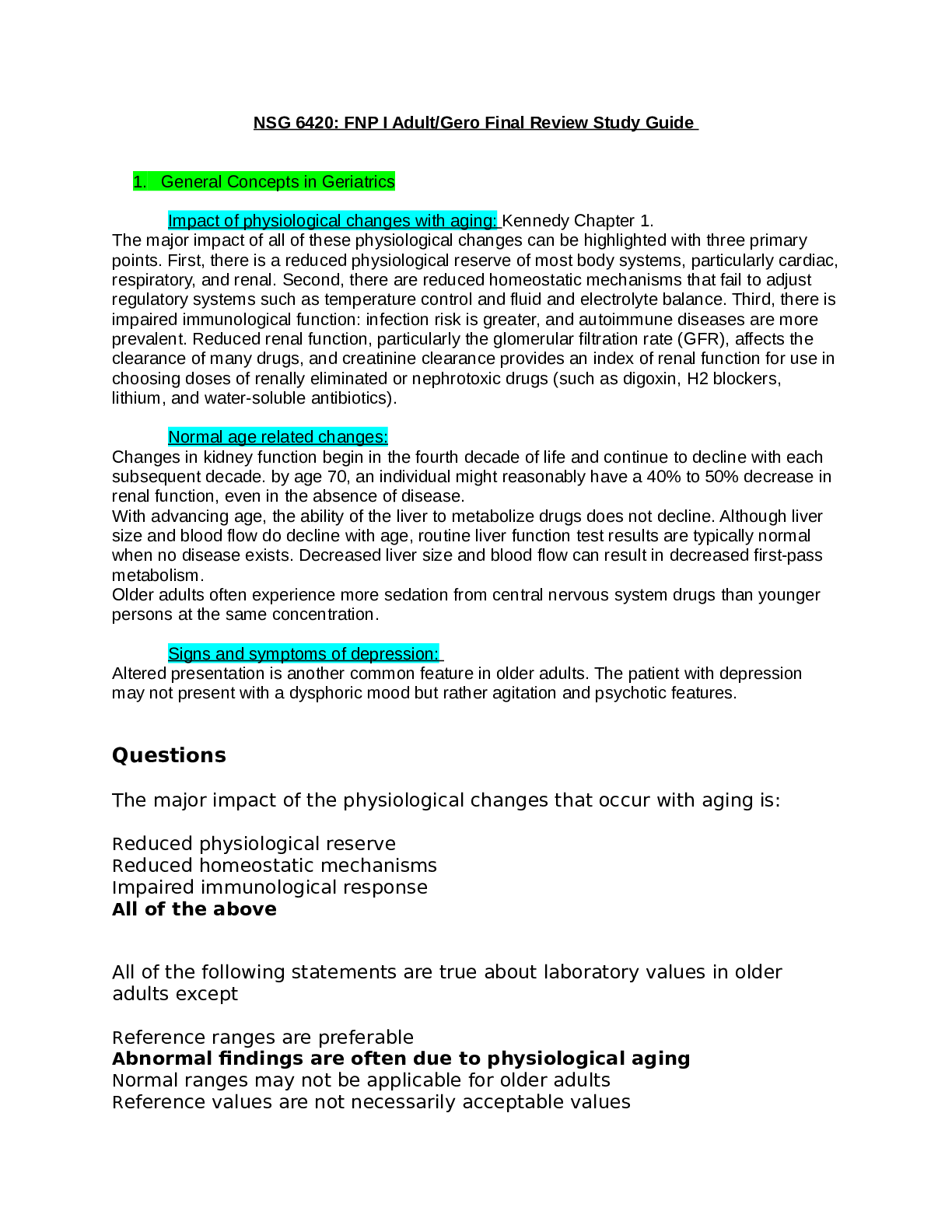
.png)
.png)












